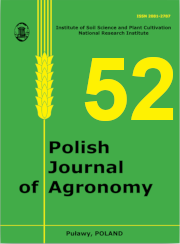Effects of different variants of basalt-sulphur improver in the fertilisation of spring oilseed rape
##plugins.themes.bootstrap3.article.main##
Abstrakt
The aim of the research was to test of several variants of basalt-sulphur improver, differing in the ratio of the two components, and to select the most suitable one for oil seed rape. Basalt dust, which is a troublesome by-product of rock processing,and elemental sulphur were used to produce the improver. The study included 3 improver variants with 1, 1.5 and 2% S and a control treatment without an improver. The experiment was conducted in concreted microplots filled with two soils: sandy loam and loamy sand, in a split-block two-factor design, in 4 replicates. The most suitable variant for rapeseed was the variant containing 1.5% S, which resulted in a 12% increase in rapeseedyield on sandy loam. Moreover, for this variant, an increasein seed fat content, an increase in the bioavailable form of sulphurin the soil and an increase in the concentration of this nutrient inoilseed rape straw and seed were observed on both soils.
##plugins.themes.bootstrap3.article.details##

Utwór dostępny jest na licencji Creative Commons Uznanie autorstwa – Na tych samych warunkach 4.0 Miedzynarodowe.
Autor udziela redakcji czasopisma Polish Journal of Agronomy (w skrócie: PJA) licencji niewyłącznej i nieodpłatnej na korzystanie z autorskich praw majątkowych do wersji papierowej/drukowanej i elektronicznej utworu Autora opublikowanego w PJA w kraju i za granicą, w całości lub w dowolnej części, w tym umieszczanie utworu w elektronicznych bazach/zbiorach danych lokalnych lub dostępnych w Internecie, przez czas nieograniczony na polach eksploatacji określonych w art. 50 ustawy o prawie autorskim i prawach pokrewnych.
Prace wydane w Polish Journal of Agronomy są udostępniane na licencji Creative Commons Uznanie autorstwa-Na tych samych warunkach 4.0 (CC-BY-SA).

